1. Problem
1.1 Introduction of Background
火力发电的基本原理是:颜料燃烧时加热水会生成蒸汽,蒸汽压力推动汽轮机旋转,然后汽轮机带动带动发电机旋转,产生电能。在这一系列的能量转化中,影响发电效率的核心是锅炉的燃烧效率,即燃料燃烧加热水产生高温高压蒸汽。锅炉的燃烧效率的影响因素很多,包括锅炉的可调参数,如燃烧给量,一二次风,引风,返料风,给水水量;以及锅炉的工况,比如锅炉床温、床压,炉膛温度、压力,过热器的温度等。我们如何使用以上的信息,根据锅炉的工况,预测产生的蒸汽量,来为我国的工业届的产量预测贡献自己的一份力量呢?
此次的案列时使用工业指标的特征,进行蒸汽量的预测。所使用的数据均为脱敏后的数据。
1.2 Data source
数据分成训练数据(train.txt)和测试数据(test.txt),其中字段 V0-V37,这 38 个字段是作为特征变量,target 作为目标变量。我们需要利用训练数据训练出模型,预测测试数据的目标变量。
数据包下载地址: Data of case。
1.3 Evaluation metrics
最终的评价指标为均方误差 ,即:
2. Data process
2.1 Load data
1 | import pandas as pd |
查看合并后的数据信息:
1 | data_all.head() |
Result:
| V0 | V1 | V2 | V3 | V4 | V5 | V6 | V7 | V8 | V9 | ... | V30 | V31 | V32 | V33 | V34 | V35 | V36 | V37 | target | oringin | |
|---|---|---|---|---|---|---|---|---|---|---|---|---|---|---|---|---|---|---|---|---|---|
| 0 | 0.566 | 0.016 | -0.143 | 0.407 | 0.452 | -0.901 | -1.812 | -2.360 | -0.436 | -2.114 | ... | 0.109 | -0.615 | 0.327 | -4.627 | -4.789 | -5.101 | -2.608 | -3.508 | 0.175 | train |
| 1 | 0.968 | 0.437 | 0.066 | 0.566 | 0.194 | -0.893 | -1.566 | -2.360 | 0.332 | -2.114 | ... | 0.124 | 0.032 | 0.600 | -0.843 | 0.160 | 0.364 | -0.335 | -0.730 | 0.676 | train |
| 2 | 1.013 | 0.568 | 0.235 | 0.370 | 0.112 | -0.797 | -1.367 | -2.360 | 0.396 | -2.114 | ... | 0.361 | 0.277 | -0.116 | -0.843 | 0.160 | 0.364 | 0.765 | -0.589 | 0.633 | train |
| 3 | 0.733 | 0.368 | 0.283 | 0.165 | 0.599 | -0.679 | -1.200 | -2.086 | 0.403 | -2.114 | ... | 0.417 | 0.279 | 0.603 | -0.843 | -0.065 | 0.364 | 0.333 | -0.112 | 0.206 | train |
| 4 | 0.684 | 0.638 | 0.260 | 0.209 | 0.337 | -0.454 | -1.073 | -2.086 | 0.314 | -2.114 | ... | 1.078 | 0.328 | 0.418 | -0.843 | -0.215 | 0.364 | -0.280 | -0.028 | 0.384 | train |
5 rows × 40 columns
2.2 Data exploration
2.2.1 EDA
由于是传感器数据,所以这些变量都是连续便来给你,故使用 kdeplot(核密度估计图)进行数据的初步分析,即 EDA。
1 | import matplotlib.pyplot as plt |
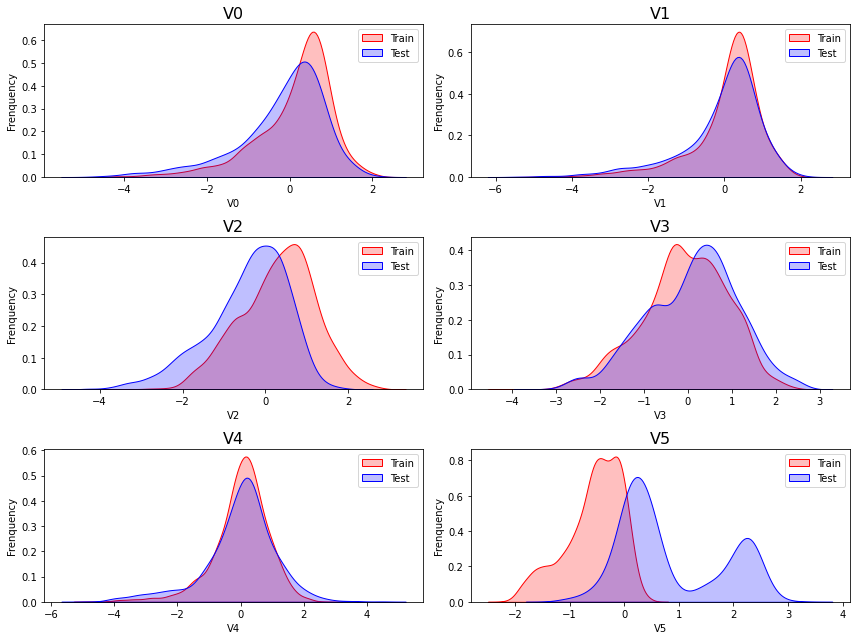
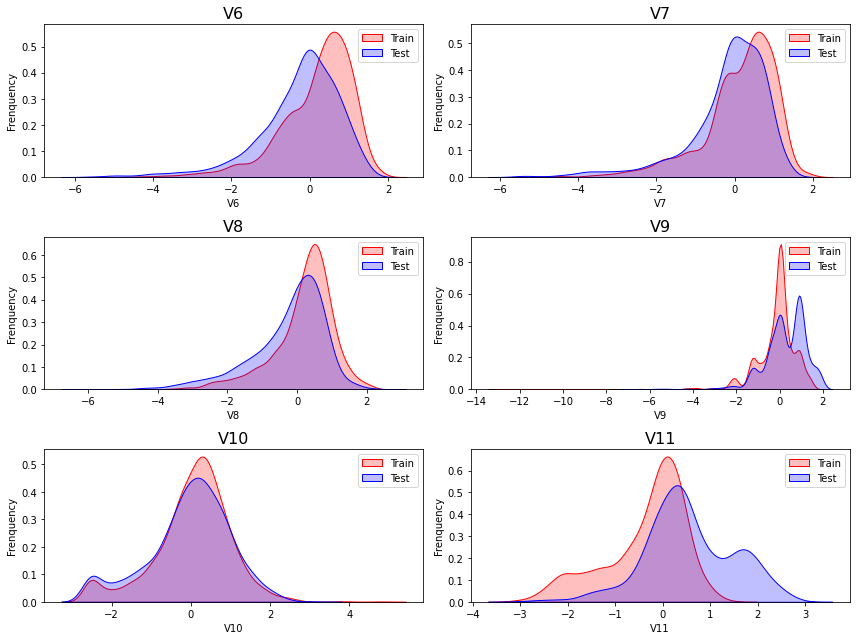
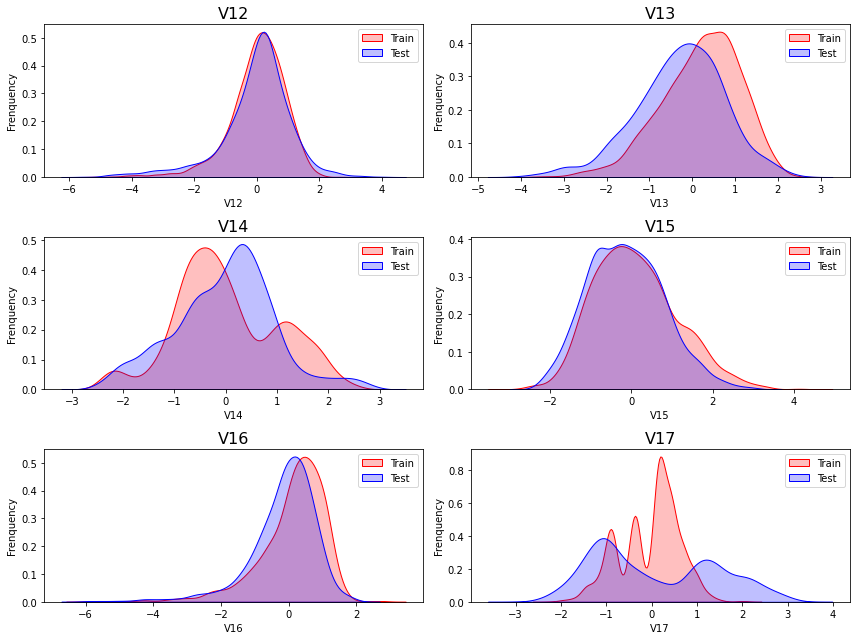



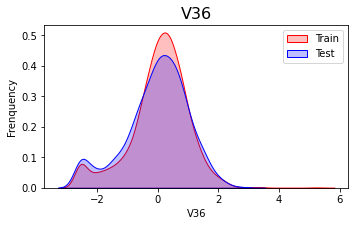

-
Delete variables
从上述的图中可以看出,特征征
V5,V9,V11,V17,V22,V28中的训练集数据分布和测试集数据分布分布不均,所以我们删除这些特则会给你数据。1
2
3
4
5
6
7
8
9
10
11
12
13
14
15
16
17
18
19f = plt.figure(figsize = (12, 9))
drop_columns = ['V5', 'V9', 'V11', 'V17', 'V22', 'V28']
for i in range(6):
column = drop_columns[i]
# ax = f.add_subplot(4, 3, j+1) # 当 num_subfit = 12 时使用
ax = f.add_subplot(3, 2, i+1) # 当 num_subfit = 6 时使用
sns.kdeplot(data_all[column][(data_all["oringin"] == "train")],
color="Red", shade = True)
sns.kdeplot(data_all[column][(data_all["oringin"] == "test")],
ax = ax, color="Blue", shade= True)
ax.set_title(column, fontsize = 16)
ax.set_xlabel(column)
ax.set_ylabel('Frenquency')
ax.legend(['Train', 'Test'])
plt.tight_layout()
plt.show()
data_all.drop(["V5","V9","V11","V17","V22","V28"],axis=1,inplace=True)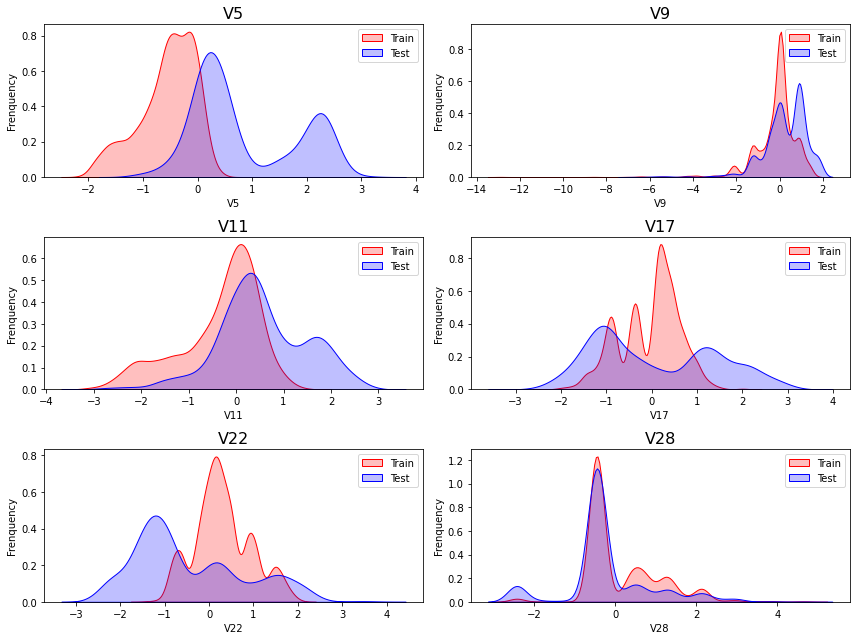
2.2.2 Dimentsionality
1 | import numpy as np |
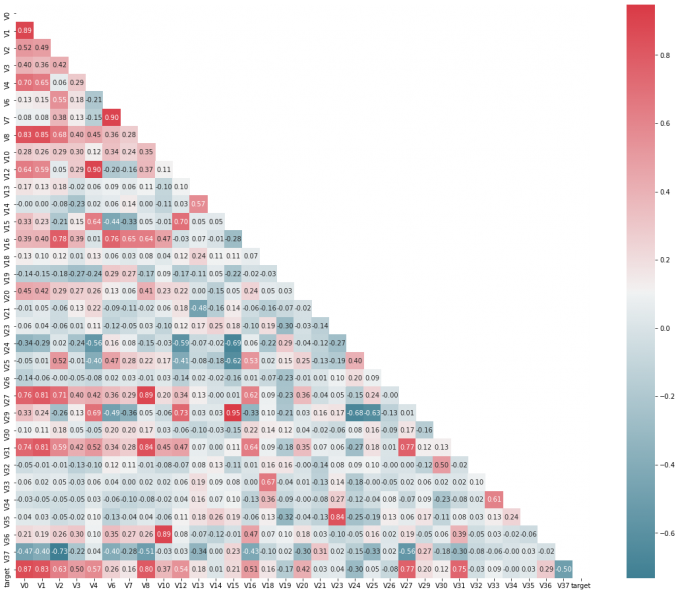
-
降维操作
可以发现部分特征 (
V14, V21, V22, V25, V26, V32, V33, V34, V35) 与target的相关性非常小,其中可能包含几乎很少的对target 的预测信息,因此,对这些变量进行剔除。1
2
3
4threshold = 0.1
corr_matrix = data_train1.corr().abs()
drop_col=corr_matrix[corr_matrix["target"]<threshold].index
data_all.drop(drop_col,axis=1,inplace=True) -
Normalization
1
2
3
4
5
6
7cols_numeric = list(data_all.columns)
cols_numeric.remove('oringin')
def scale_minmax(col):
return (col - col.min())/(col.max()-col.min())
scale_cols = [col for col in cols_numeric if col != 'target']
data_all[scale_cols] = data_all[scale_cols].apply(scale_minmax,axis=0)
data_all[scale_cols].describe()V0 V1 V2 V3 V4 V6 V7 V8 V10 V12 ... V20 V23 V24 V27 V29 V30 V31 V35 V36 V37 count 4813.000000 4813.000000 4813.000000 4813.000000 4813.000000 4813.000000 4813.000000 4813.000000 4813.000000 4813.000000 ... 4813.000000 4813.000000 4813.000000 4813.000000 4813.000000 4813.000000 4813.000000 4813.000000 4813.000000 4813.000000 mean 0.694172 0.721357 0.602300 0.603139 0.523743 0.748823 0.745740 0.715607 0.348518 0.578507 ... 0.456147 0.744438 0.356712 0.881401 0.388683 0.589459 0.792709 0.762873 0.332385 0.545795 std 0.144198 0.131443 0.140628 0.152462 0.106430 0.132560 0.132577 0.118105 0.134882 0.105088 ... 0.134083 0.134085 0.265512 0.128221 0.133475 0.130786 0.102976 0.102037 0.127456 0.150356 min 0.000000 0.000000 0.000000 0.000000 0.000000 0.000000 0.000000 0.000000 0.000000 0.000000 ... 0.000000 0.000000 0.000000 0.000000 0.000000 0.000000 0.000000 0.000000 0.000000 0.000000 25% 0.626676 0.679416 0.514414 0.503888 0.478182 0.683324 0.696938 0.664934 0.284327 0.532892 ... 0.370475 0.719362 0.040616 0.888575 0.292445 0.550092 0.761816 0.727273 0.270584 0.445647 50% 0.729488 0.752497 0.617072 0.614270 0.535866 0.774125 0.771974 0.742884 0.366469 0.591635 ... 0.447305 0.788817 0.381736 0.916015 0.375734 0.594428 0.815055 0.800020 0.347056 0.539317 75% 0.790195 0.799553 0.700464 0.710474 0.585036 0.842259 0.836405 0.790835 0.432965 0.641971 ... 0.522660 0.792706 0.574728 0.932555 0.471837 0.650798 0.852229 0.800020 0.414861 0.643061 max 1.000000 1.000000 1.000000 1.000000 1.000000 1.000000 1.000000 1.000000 1.000000 1.000000 ... 1.000000 1.000000 1.000000 1.000000 1.000000 1.000000 1.000000 1.000000 1.000000 1.000000 8 rows × 25 columns
2.3.3 Features engineering
绘图显示
Box-Cox变换对数据分布影响,Box-Cox用于连续的响应变量不满足正态分布的情况。在进行Box-Cox变换之后,可以一定程度上减少不可观测的误差和预测变量的相关性。quantitle-quantile(q-q)图,可参考 QQ图,stats.probplot1
2
3
4
5
6
7
8
9
10
11
12
13
14
15
16
17
18
19
20
21
22
23
24
25
26
27
28
29
30
31
32
33
34
35
36
37
38
39
40
41
42
43
44
45
46
47
48
49
50import warnings
warnings.filterwarnings("ignore")
from scipy import stats
fcols = 6
frows = len(cols_numeric)-1
plt.figure(figsize=(4*fcols,4*frows))
i=0
for var in cols_numeric:
if var!='target':
dat = data_all[[var, 'target']].dropna()
i+=1
plt.subplot(frows,fcols,i)
sns.distplot(dat[var] , fit=stats.norm);
plt.title(var+' Original')
plt.xlabel('')
i+=1
plt.subplot(frows,fcols,i)
_=stats.probplot(dat[var], plot=plt)
plt.title('skew='+'{:.4f}'.format(stats.skew(dat[var])))
plt.xlabel('')
plt.ylabel('')
i+=1
plt.subplot(frows,fcols,i)
plt.plot(dat[var], dat['target'],'.',alpha=0.5)
plt.title('corr='+'{:.2f}'.format(np.corrcoef(dat[var], dat['target'])[0][1]))
i+=1
plt.subplot(frows,fcols,i)
trans_var, lambda_var = stats.boxcox(dat[var].dropna()+1)
trans_var = scale_minmax(trans_var)
sns.distplot(trans_var , fit=stats.norm);
plt.title(var+' Tramsformed')
plt.xlabel('')
i+=1
plt.subplot(frows,fcols,i)
_=stats.probplot(trans_var, plot=plt)
plt.title('skew='+'{:.4f}'.format(stats.skew(trans_var)))
plt.xlabel('')
plt.ylabel('')
i+=1
plt.subplot(frows,fcols,i)
plt.plot(trans_var, dat['target'],'.',alpha=0.5)
plt.title('corr='+'{:.2f}'.format(np.corrcoef(trans_var,dat['target'])[0][1]))
-
Box-Cox 变换
1
2
3
4
5
6
7
8
9
10
11# 进行Box-Cox变换
cols_transform=data_all.columns[0:-2]
for col in cols_transform:
# transform column
data_all.loc[:,col], _ = stats.boxcox(data_all.loc[:,col]+1)
print(data_all.target.describe())
plt.figure(figsize=(12,4))
plt.subplot(1,2,1)
sns.distplot(data_all.target.dropna() , fit=stats.norm);
plt.subplot(1,2,2)
_=stats.probplot(data_all.target.dropna(), plot=plt)Results:
1
2
3
4
5
6
7
8
9count 2888.000000
mean 0.126353
std 0.983966
min -3.044000
25% -0.350250
50% 0.313000
75% 0.793250
max 2.538000
Name: target, dtype: float64
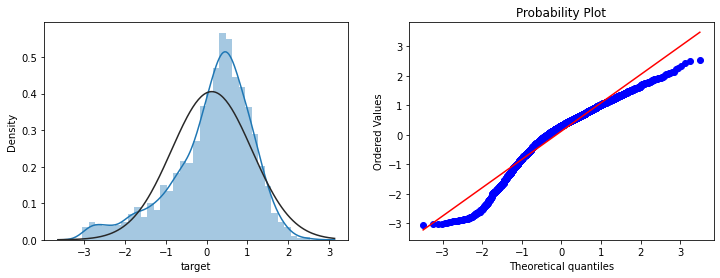
-
对数变换
target使用对数变换
target目标提升特征数量的正态性,可以参考知乎文章:在统计学中为什么要对变量取对数?1
2
3
4
5
6
7
8
9sp = data_train.target
data_train.target1 = np.power(1.5,sp)
print(data_train.target1.describe())
plt.figure(figsize=(12,4))
plt.subplot(1,2,1)
sns.distplot(data_train.target1.dropna(),fit=stats.norm);
plt.subplot(1,2,2)
_ = stats.probplot(data_train.target1.dropna(), plot=plt)Results:
1
2
3
4
5
6
7
8
9count 2888.000000
mean 1.129957
std 0.394110
min 0.291057
25% 0.867609
50% 1.135315
75% 1.379382
max 2.798463
Name: target, dtype: float64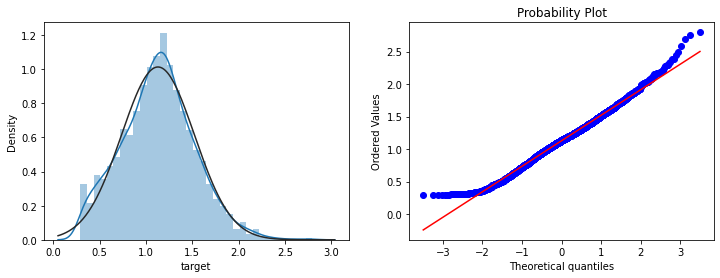
3. Model construction
3.1 Self definition fuction
-
Train set and Test set
1
2
3
4
5
6
7
8
9
10
11
12
13
14
15
16
17
18from sklearn.model_selection import train_test_split
# function to get training samples
def get_training_data():
# extract training samples
df_train = data_all[data_all["oringin"]=="train"]
df_train["label"] = data_train.target1
# split SalePrice and features
y = df_train.target
X = df_train.drop(["oringin","target","label"], axis=1)
X_train,X_valid,y_train,y_valid=train_test_split(X,
y,test_size=0.3,random_state=100)
return X_train,X_valid,y_train,y_valid
# extract test data (without SalePrice)
def get_test_data():
df_test = data_all[data_all["oringin"]=="test"].reset_index(drop=True)
return df_test.drop(["oringin","target"],axis=1) -
Evaluation metrics
1
2
3
4
5
6
7
8
9
10
11
12
13
14
15
16
17from sklearn.metrics import make_scorer,mean_squared_error
# metric for evaluation
def rmse(y_true, y_pred):
diff = y_pred - y_true
sum_sq = sum(diff**2)
n = len(y_pred)
return np.sqrt(sum_sq/n)
def mse(y_ture,y_pred):
return mean_squared_error(y_ture,y_pred)
# scorer to be used in sklearn model fitting
rmse_scorer = make_scorer(rmse, greater_is_better=False)
# 输入的score_func为记分函数时,该值为True(默认值);输入函数为损失函数时,该值为False
mse_scorer = make_scorer(mse, greater_is_better=False) -
Outliers
1
2
3
4
5
6
7
8
9
10
11
12
13
14
15
16
17
18
19
20
21
22
23
24
25
26
27
28
29
30
31
32
33
34
35
36
37
38
39
40
41
42
43
44
45
46
47
48
49
50
51
52
53
54
55
56
57
58
59
60
61
62from sklearn.linear_model import Ridge
# function to detect outliers based on the predictions of a model
def find_outliers(model, X, y, sigma=3):
# predict y values using model
model.fit(X,y)
y_pred = pd.Series(model.predict(X), index=y.index)
# calculate residuals between the model prediction and true y values
resid = y - y_pred
mean_resid = resid.mean()
std_resid = resid.std()
# calculate z statistic, define outliers to be where |z|>sigma
z = (resid - mean_resid)/std_resid
outliers = z[abs(z)>sigma].index
# print and plot the results
print('R2=',model.score(X,y))
print('rmse=',rmse(y, y_pred))
print("mse=",mean_squared_error(y,y_pred))
print('---------------------------------------')
print('mean of residuals:',mean_resid)
print('std of residuals:',std_resid)
print('---------------------------------------')
print(len(outliers),'outliers:')
print(outliers.tolist())
plt.figure(figsize=(15,5))
ax_131 = plt.subplot(1,3,1)
plt.plot(y,y_pred,'.')
plt.plot(y.loc[outliers],y_pred.loc[outliers],'ro')
plt.legend(['Accepted','Outlier'])
plt.xlabel('y')
plt.ylabel('y_pred');
ax_132=plt.subplot(1,3,2)
plt.plot(y,y-y_pred,'.')
plt.plot(y.loc[outliers],y.loc[outliers]-y_pred.loc[outliers],'ro')
plt.legend(['Accepted','Outlier'])
plt.xlabel('y')
plt.ylabel('y - y_pred');
ax_133=plt.subplot(1,3,3)
z.plot.hist(bins=50,ax=ax_133)
z.loc[outliers].plot.hist(color='r',bins=50,ax=ax_133)
plt.legend(['Accepted','Outlier'])
plt.xlabel('z')
return outliers
# get training data
X_train, X_valid,y_train,y_valid = get_training_data()
test=get_test_data()
# find and remove outliers using a Ridge model
outliers = find_outliers(Ridge(), X_train, y_train)
X_outliers=X_train.loc[outliers]
y_outliers=y_train.loc[outliers]
X_t=X_train.drop(outliers)
y_t=y_train.drop(outliers)Results:
1
2
3
4
5
6
7
8
9
10R2= 0.8760125992975717
rmse= 0.3499365298917651
mse= 0.12245557495269015
---------------------------------------
mean of residuals: -3.28946831838468e-16
std of residuals: 0.3500231371273175
---------------------------------------
21 outliers:
[2655, 2159, 1164, 2863, 1145, 2697, 2528, 2645, 691, 1874,
2647, 884, 2696, 2668, 1310, 1901, 1458, 2769, 2002, 2669, 1972]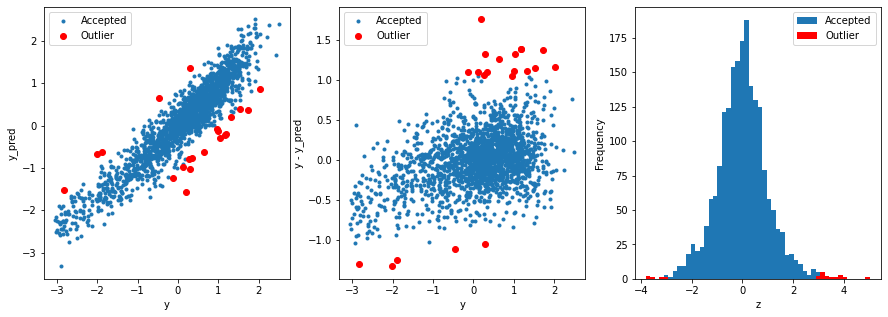
3.2 Model training
1
2
3
4
5def get_trainning_data_omitoutliers():
#获取训练数据省略异常值
y=y_t.copy()
X=X_t.copy()
return X,y1
2
3
4
5
6
7
8
9
10
11
12
13
14
15
16
17
18
19
20
21
22
23
24
25
26
27
28
29
30
31
32
33
34
35
36
37
38
39
40
41
42
43
44
45
46
47
48
49
50
51
52
53
54
55
56
57
58
59
60def train_model(model, param_grid=[], X=[], y=[],
splits=5, repeats=5):
# 获取数据
if len(y)==0:
X,y = get_trainning_data_omitoutliers()
# 交叉验证
rkfold = RepeatedKFold(n_splits=splits, n_repeats=repeats)
# 网格搜索最佳参数
if len(param_grid)>0:
gsearch = GridSearchCV(model, param_grid, cv=rkfold,
scoring="neg_mean_squared_error",
verbose=1, return_train_score=True)
# 训练
gsearch.fit(X,y)
# 最好的模型
model = gsearch.best_estimator_
best_idx = gsearch.best_index_
# 获取交叉验证评价指标
grid_results = pd.DataFrame(gsearch.cv_results_)
cv_mean = abs(grid_results.loc[best_idx,'mean_test_score'])
cv_std = grid_results.loc[best_idx,'std_test_score']
# 没有网格搜索
else:
grid_results = []
cv_results = cross_val_score(model, X, y, scoring="neg_mean_squared_error", cv=rkfold)
cv_mean = abs(np.mean(cv_results))
cv_std = np.std(cv_results)
# 合并数据
cv_score = pd.Series({'mean':cv_mean,'std':cv_std})
# 预测
y_pred = model.predict(X)
# 模型性能的统计数据
print('----------------------')
print(model)
print('----------------------')
print('score=',model.score(X,y))
print('rmse=',rmse(y, y_pred))
print('mse=',mse(y, y_pred))
print('cross_val: mean=',cv_mean,', std=',cv_std)
# 残差分析与可视化
y_pred = pd.Series(y_pred,index=y.index)
resid = y - y_pred
mean_resid = resid.mean()
std_resid = resid.std()
z = (resid - mean_resid)/std_resid
n_outliers = sum(abs(z)>3)
outliers = z[abs(z)>3].index
return model, cv_score, grid_results1
2
3
4
5
6
7
8
9
10
11
12
13
14
15
16
17
18
19
20
21
22
23
24
25from sklearn.model_selection import GridSearchCV, RepeatedKFold, cross_val_score,cross_val_predict,KFold
from sklearn.linear_model import Ridge
# 定义训练变量存储数据
opt_models = dict()
score_models = pd.DataFrame(columns=['mean','std'])
splits=5
repeats=5
model = 'Ridge'
opt_models[model] = Ridge()
alph_range = np.arange(0.25,6,0.25)
param_grid = {'alpha': alph_range}
opt_models[model],cv_score,grid_results = train_model(opt_models[model],
param_grid=param_grid, splits=splits, repeats=repeats)
cv_score.name = model
score_models = score_models.append(cv_score)
plt.figure()
plt.errorbar(alph_range, abs(grid_results['mean_test_score']),
abs(grid_results['std_test_score'])/np.sqrt(splits*repeats))
plt.xlabel('alpha')
plt.ylabel('score')Results:
Fitting 25 folds for each of 23 candidates, totalling 575 fits ---------------------- Ridge(alpha=0.25) ---------------------- score= 0.8914965873982021 rmse= 0.32638045120253134 mse= 0.1065241989271679 cross_val: mean= 0.11019851747204477 , std= 0.006413351282774973 Text(0, 0.5, 'score')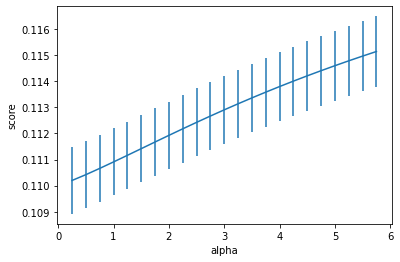
-
Forecasting function
1
2
3
4
5
6
7
8
9
10
11
12
13
14
15
16
17
18
19# 预测函数
def model_predict(test_data,test_y=[]):
i=0
y_predict_total=np.zeros((test_data.shape[0],))
for model in opt_models.keys():
if model!="LinearSVR" and model!="KNeighbors":
y_predict=opt_models[model].predict(test_data)
y_predict_total+=y_predict
i+=1
if len(test_y)>0:
print("{}_mse:".format(model),mean_squared_error(y_predict,test_y))
y_predict_mean=np.round(y_predict_total/i,6)
if len(test_y)>0:
print("mean_mse:",mean_squared_error(y_predict_mean,test_y))
else:
y_predict_mean=pd.Series(y_predict_mean)
return y_predict_mean
3.3 预测并保存结果
1
2y_ = model_predict(test)
y_.to_csv('predict.txt',header = None,index = False)-------------This blog is over! Thanks for your reading------------- -
